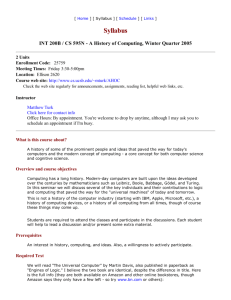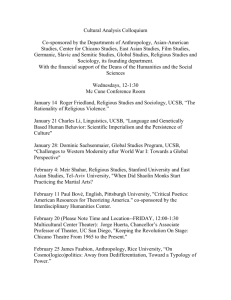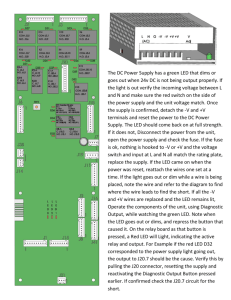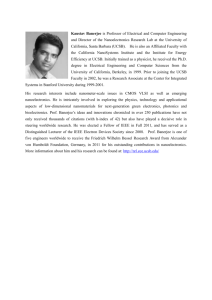Data Acquisition Information Management
advertisement
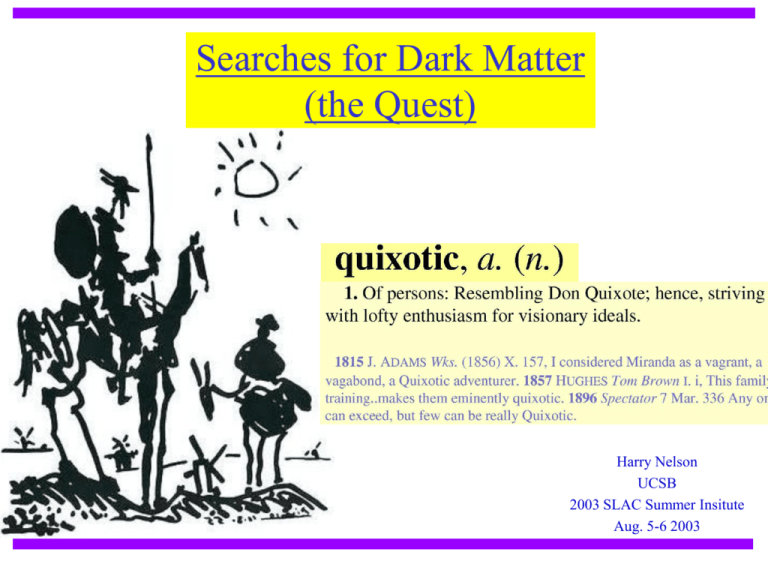
Searches for Dark Matter (the Quest) Harry Nelson UCSB 2003 SLAC Summer Insitute Aug. 5-6 2003 HNN UCSB Recap - Direct Detection How to dredge the small (0.01 DRU= ev/(kg d keV)) up out of a bigger background (1 DRU typical) of recoil electrons from comptons? • Shield (shield radioactive too!)… 1 ev/(kg d keV) typical • Reduce the background… HDMS , IGEX , Genius • Exploit astron. propert. (year cycle, directionality) DAMA, DRIFT • Devise detectors that can distinguish nuclear recoil from electron recoil… Edelweiss, CDMS, Xenon.. Indirect Detection (milli-) Charged Massive Particles Closing 8/6/03 SLAC Summer Institute 2 HNN UCSB Annual Modulation in Rate • `Usual Simplification’: Halo particles are at rest, on average 2 1/2 vDM =0 km/s • Sun moves through Halo - `apparent’ wind • Earth modulates `wind’ velocity yearly vk = 15 km/s vDM1/2 300 km/s 2 Fig. from DRIFT DAMA at Gran Sasso Peak-to-peak up to 40% 8/6/03 SLAC Summer Institute 3 HNN UCSB Daily Modulation in Direction • Recoiling Nucleus Follows the Initial WIMP Direction… the `wind’ • Detector gaseous to reconstruct recoil direction • DRIFT at Boulby (Spooner) Fig. from DRIFT 8/6/03 SLAC Summer Institute 4 UCSB Copper NaI Lead PMT DAMA – 100 kg of NaI PMT HNN Poly Sodium, A=23 Eobs(KeVee)0.25 Erecoil (KeV) Erecoil Light Iodine, A=127 Eobs(KeVee)0.09 Erecoil (KeV) 8/6/03 SLAC Summer Institute 5 HNN UCSB DAMA Background and Signal 0.01950.031 -0.00010.019 cpd/kg/keV Energy Spectrum Bkgd 1 cpd/kg/keV 2-6 KeV 8-24 KeV Na(23) 20-70 KeV I(127) through through2000 2003… …4 6.3 Bernabei et al., astro-ph/0307403 8/6/03 SLAC Summer Institute 6 HNN UCSB DAMA noise... >1 pe threshold <10-4 cpd... 8/6/03 SLAC Summer Institute 7 HNN UCSB DAMA Allowed Regions p (cm2), =0 / through 2000 10-44 Na (standard halo) through 2003 3 10-42 I 4 • Variation mainly due to changes in halo parameters • two plots not directly comparable (different halos used) • With new result, DAMA ceases to employ `standard Maxwellian halo’ - comparisons challenging 8/6/03 SLAC Summer Institute 8 HNN Halo Variation UCSB Kamionkowski and Kinkhabwala (1997) 8/6/03 SLAC Summer Institute 9 HNN UCSB Perhaps WIMP couples not to nucleons, S,V,T,A,P S,A non-relativistic (V too) but to their spin S - `nucleon, SI’ (or V) … A - `spin or SD’ A2 2 J(J+1) J0 unpaired nucleon, odd A (also, could break isospin… np) p (cm2) Couple to neutron spin 10-34 10-36 NAIAD (Boulby) (couple to proton spin) DAMA LIBRA 250kg, NAIAD continues, ANAIS in Spain... 8/6/03 SLAC Summer Institute 10 HNN Discrimination of Recoils Signal Background Nucleus Recoils Electron Recoils Er v/c 710-4 Dense Energy Deposition v/c small; Bragg 0 8/6/03 UCSB Er v/c 0.3 Sparse Energy Deposition Differences the Basis of Discrimination SLAC Summer Institute 11 HNN UCSB Simulation (by DRIFT) 13 keV e- in 1/20 atm Ar 40 keV Ar in 1/20 atm Ar Ar pushes other Ar atoms, none go very far. Electron pushes other electrons, all go far 5 cm 8/6/03 SLAC Summer Institute 12 HNN UCSB dE/dx for different recoils http://www.srim.org/SRIM/SRIM2003.htm Strategies Detector insensitive to small dE/dx (track etch, SDD) Convert E to two distinct measured quantities that look different depending on whether nuclear recoil or electron. 8/6/03 SLAC Summer Institute 13 HNN UCSB Track Etch Detectors Struck Nucleus Corrosive Etch Mica, CR39 Large dE/dx Ancient Mica 0.5109 yr Exposure fraction mm2 area 100 Å http://moedal.web.cern.ch/moedal/moedal_track.htm 8/6/03 SLAC Summer Institute 14 HNN UCSB Mica Result Snoden-Ifft, Freeman, Price (1994) 58% 16O 16% 28Si 12% 27Al 5% 39K p (cm2) 10-37cm2 SD: 10-33cm2 8/6/03 SLAC Summer Institute 15 HNN UCSB Superheated Droplet Detector (SDD) Target, C2ClF5 (Liquid): Temp. > Boiling Gelatin 15 gm 10 m Collar et al., (2000) 8/6/03 0 10-36 cm2 Spin Dependent SLAC Summer Institute 16 HNN Lose the Gelatin… get all Target UCSB Really a bubble chamber... CF3Br Juan Collar and Andrew Sonnenschein (poster session) 8/6/03 SLAC Summer Institute 17 HNN UCSB Distinct Quantities to Measure 1) Time Structure of the Pulse 2) Pulse Height/Area via: a) Ionization (like Ge) b) Scintillation (like NaI) c) Heat/Phonons d) Physical Size of Ionization Liquid Xenon Also a scintillator 1 10-20keV (50-100 keV ER) 0.1 (Spooner) 0.01 e- recoils from ’s 0.001 0.0001 NaI 0.00001 1 NaI 10 100 pulse time constant (ns) 1 ’s Nuclear recoils From neutrons 0.1 DAMA does not use this 0.01 0.001 ER: 130-150 KeV (I) t 0.0001 0.00001 1 1 Gerbier et al., 1998 8/6/03 Width of pulse SLAC Summer Institute 10 10 pulse time constant ns t (ns) 100 100 18 HNN UCSB Distinguishing Nuclear Recoil Nuclear recoil energy lost mainly to collisions with other nuclei to electrons 8/6/03 Nuclear recoils deposit lots of energy in lattice excitations: phonons... heat Nuclear motion poor at causing electronic excitation, ionization to electrons SLAC Summer Institute 19 HNN UCSB Simultaneous Measurement of Phonons(Heat) + Ionization Edelweiss Temperature-20 mK E D(Temp)NTD Ge D(Temp)/D(Energy) Slow (10’s ms) Ionization - E applied Background (e- from ) … strong ionization signal… equal phonon signal (!) Nuclear recoil… reduced (by 1/4) ionization signal, strong phonon signal 8/6/03 SLAC Summer Institute 20 HNN UCSB Separation of Nuclear Recoil from e- Recoil Nuclear recoils (induced by a neutron source) Electron recoils (induced by a source) Slope really 1! Ionization =1 (bkgd) 1/3 (sig) Phonons Egap = 3/4 eV w = 3 eV Shutt et al., 1992 8/6/03 SLAC Summer Institute 21 HNN UCSB Edelweiss (depth: 4500 mwe) 0.32 kg/ Ge detector L. Chabert, EPS `03 Aachen 8/6/03 Roman Lead 3×0.32kg Germanium Detectors SLAC Summer Institute 22 HNN Edelweiss Data: ’s Suppressed by 1000 Bolometer 1 Bolometer 2 7.51 kg.d exposure (fiducial volume) ● Best charg. channel : 1 keV (FWHM) ● 20 keV threshold L. Chabert, ● EPS `03 Aachen 8/6/03 UCSB Bolometer 3 ● 10.86 kg.d (fiducial) 3.72 kg.d ● Good phonon channel (fiduc.) 300 eV (FWHM) ● Smaller resolution during most exposure due to of the runs electronics ● Noisy charge channel problems ● 30 keV threshold ● 30 keV threshold 23 SLAC Summer Institute ● HNN UCSB Betas... External z GermaniumElectrode Implants Ionization electrons get trapped in this electrode E Those electrons never drift over to the other electrode… ionization signal reduced… but, all the phonons/heat still present… (ionization)/(phonons) < 1 CDMS effort: measure z 8/6/03 SLAC Summer Institute 24 HNN Edelweiss and other’s results UCSB CDMS no background subtraction hepex/0306001 28 kg-days CDMS with (Ge, background phonon/ion.) subtraction hepex/0306001 28 kg-days (Ge, ZEPLIN I (preliminary) phonon/ion.) 230 kg-days (Liq Xe) DAMA/Edelweiss inconsistent at 99.9%... ... not accounting for differential systematics EDELWEISS 2003 no background subtraction 31 kg-days (Ge, phonon/ion L. Chabert, EPS `03 Aachen 8/6/03 SLAC Summer Institute 25 HNN CDMS: not as deep… neutron background UCSB 17 mwe Active Muon Veto Pb Shield n Copper n Fridge Polyethylene Detectors Inner Pb shield ... Experiment moved to Soudan, 2100 mwe depth R. Schnee 8/6/03 SLAC Summer Institute 26 HNN UCSB CDMS Layout, Data FET cards 1/5000 ’s misid’ed as nuclear recoils SQUID cards 4K 0.6 K 0.06 K 0.02 K ZIP 1 (Ge) ZIP 2 (Ge) ZIP 3 (Ge) ZIP 4 (Si) ZIP 5 (Ge) ZIP 6 (Si) 8 cm 4 Germanium Detectors (0.66 kg total) 2 Silicon Detectors (0.2 kg total) Small DM rate, high neutron rate R. Schnee 8/6/03 SLAC Summer Institute Surface electrons Z1 () or Z5 (+) Nuclear Recoils 27 HNN UCSB Technology of `ZIP’s (Z for z) Very different from Edelweiss, although the objective is the same… the `phono-cathode’ quasiparticle trap W quasiparticle Transition-Edge diffusion Sensor (TES) Al Collector Cooper Pair Al Si or Ge phonons ~ 10mK R. Schnee 8/6/03 RTES () • Signal much faster microseconds • 3-d imaging (Z) normal 4 3 2 1 superconducting SLAC Summer Institute Tc ~ 80mK T (mK) 28 HNN UCSB The ZIP Phono`cathode’... 1 tungsten 380 x 60 aluminum fins • 4 segments + timing to get x,y on the face • rise time to get z, into the face R. Schnee 8/6/03 SLAC Summer Institute 29 HNN ZIP Surface Electron Rejection UCSB (Single-scatter) Neutrons Surfaceelectron recoils photons from from (selected via nearest- 60Co Source 252Cf neighbor multiple source scatters from 60Co source) Accept Surface electrons still likely to be the limiting background Reject R. Schnee 8/6/03 SLAC Summer Institute 30 HNN CDMS Expected Background Levels UCSB In DRU, ev/kg/kev/day 0.00014 0.0005 a bit dated; now X10 better, surface electron X2 better 0.00074 0.0024 CDMS-II Proposal 8/6/03 SLAC Summer Institute 31 HNN UCSB Catalog of Recoil Experiments Rick Gaitskell 8/6/03 SLAC Summer Institute 32 HNN UCSB Rick Gaitskell Future Performances 8/6/03 SLAC Summer Institute 33 HNN Prognostication 8/6/03 SLAC Summer Institute UCSB 34 HNN A Proposal… 5 billion years ago… UCSB (indirect DM detection) Get 1057 protons in a sphere (ignite to enable a neutrino program) Wait for WIMPs to collect (spin-dependent cross section - proton’s spin) Detect on a nearby iron ball via the annihilation of WIMPs (with themselves) to neutrinos Review Panel’s Recommendations/Queries: 1)What if WIMP’s don’t self annihilate… no answer 2) Hey, you’re `iron ball’ is great for collecting WIMPS via spin-independent scattering, since A of Iron is big (54)! (thanks) 3) Funding for preliminary studies... 8/6/03 SLAC Summer Institute 35 HNN UCSB Study Results... For SUSY WIMPs… 1) Sun, rate bottleneck is capture not annihilation 2) Earth, situation reversed 3) `Relative Efficiency’ function of WIMP mass Earth… best when WIMP mass same as Iron mass… same reason hydrogen is the best neutron moderator lower masses… little capture 8/6/03 Sun SLAC Summer Institute 36 HNN UCSB Solar/Earth Comparison (for detector on Earth) (WIMP models for spin/scalar comparison) 8/6/03 Annihilation Rate in Earth is Earth Bottleneck Capture Rate in Earth is Earth Bottlneck SLAC Summer Institute 37 HNN Super-Kamiokande’s Results... UCSB Upward going muons Desai, IDM 02 8/6/03 SLAC Summer Institute 38 HNN UCSB Transcribe to the Direct Detection Plot Model dependent… but less so than I thought. Spin-dependent (Sun) Scalar (Earth) Desai, IDM 02 8/6/03 SLAC Summer Institute 39 HNN UCSB Future Indirect Detectors (neutrino) Feng, Matchev, Wilczek 2000 8/6/03 SLAC Summer Institute 40 HNN UCSB Cosmic Positrons - Halo WIMP annililation HEAT… terrific balloon experiment… saw an excess Edsjo, IDM 02 8/6/03 SLAC Summer Institute 41 HNN Positron Future… ’s too UCSB Feng, Matchev, Wilczek 2000 8/6/03 SLAC Summer Institute 42 HNN 1021 1018 UCSB Milli-CHAMP Limits 1015 1012 Excluded Regions m (GeV) 109 106 103 Overclose Universe (Thermal) 1 10-3 10-6 10-9 8/6/03 Davidson, Hannestad, Raffelt, hep-ph/0001179 SLAC Summer Institute Charge Fraction 43 HNN UCSB Stable CHAMPs in Matter DM, stop in earth Perl et al., hep-ph/0102033 8/6/03 SLAC Summer Institute 44 HNN UCSB Some conclusions Rutherford/Chadwick hunted neutron for 12 years Neutrino studies started about 90 years ago… Hints first seen on continent, interpreted as photons… Masses? Majorana? Still not fully nailed down... Dark Matter… Prepare for a long ride… no physical law guarantees that discoveries happen within any human’s lifetime The only guarantee: if we fail to look, we will fail to find. 8/6/03 SLAC Summer Institute 45
